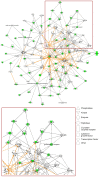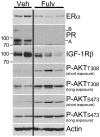Abrogating endocrine resistance by targeting ERα and PI3K in breast cancer
- PMID: 23087906
- PMCID: PMC3472546
- DOI: 10.3389/fonc.2012.00145
Abrogating endocrine resistance by targeting ERα and PI3K in breast cancer
Abstract
Antiestrogen therapies targeting estrogen receptor α (ER) signaling are a mainstay for patients with ER+ breast cancer. While many cancers exhibit resistance to antiestrogen therapies, a large body of clinical and experimental evidence indicates that hyperactivation of the phosphatidylinositol 3-kinase (PI3K) pathway promotes antiestrogen resistance. In addition, continued ligand-independent ER signaling in the setting of estrogen deprivation may contribute to resistance to endocrine therapy. PI3K activates several proteins which promote cell cycle progression and survival. In ER+ breast cancer cells, PI3K promotes ligand-dependent and -independent ER transcriptional activity. Models of antiestrogen-resistant breast cancer often remain sensitive to estrogen stimulation and PI3K inhibition, suggesting that clinical trials with combinations of drugs targeting both the PI3K and ER pathways are warranted. Herein, we review recent findings on the roles of PI3K and ER in antiestrogen resistance, and clinical trials testing drug combinations which target both pathways. We also discuss the need for clinical investigation of ER downregulators in combination with PI3K inhibitors.
Keywords: PI3K; antiestrogen; aromatase; breast cancer; estrogen receptor; fulvestrant; tamoxifen.
Figures



Similar articles
-
Phosphatidylinositol 3-kinase and antiestrogen resistance in breast cancer.J Clin Oncol. 2011 Nov 20;29(33):4452-61. doi: 10.1200/JCO.2010.34.4879. Epub 2011 Oct 17. J Clin Oncol. 2011. PMID: 22010023 Free PMC article. Review.
-
Preclinical modeling of combined phosphatidylinositol-3-kinase inhibition with endocrine therapy for estrogen receptor-positive breast cancer.Breast Cancer Res. 2011 Mar 1;13(2):R21. doi: 10.1186/bcr2833. Breast Cancer Res. 2011. PMID: 21362200 Free PMC article.
-
Elevated insulin-like growth factor 1 receptor signaling induces antiestrogen resistance through the MAPK/ERK and PI3K/Akt signaling routes.Breast Cancer Res. 2011 May 19;13(3):R52. doi: 10.1186/bcr2883. Breast Cancer Res. 2011. PMID: 21595894 Free PMC article.
-
Strategically Timing Inhibition of Phosphatidylinositol 3-Kinase to Maximize Therapeutic Index in Estrogen Receptor Alpha-Positive, PIK3CA-Mutant Breast Cancer.Clin Cancer Res. 2016 May 1;22(9):2250-60. doi: 10.1158/1078-0432.CCR-15-2276. Epub 2016 Jan 5. Clin Cancer Res. 2016. PMID: 26733612 Free PMC article.
-
Clinical utility of fulvestrant in the treatment of breast cancer: a report on the emerging clinical evidence.Cancer Manag Res. 2018 Aug 30;10:3083-3099. doi: 10.2147/CMAR.S137772. eCollection 2018. Cancer Manag Res. 2018. PMID: 30214302 Free PMC article. Review.
Cited by
-
The PI3K inhibitor taselisib overcomes letrozole resistance in a breast cancer model expressing aromatase.Genes Cancer. 2016 Mar;7(3-4):73-85. doi: 10.18632/genesandcancer.100. Genes Cancer. 2016. PMID: 27382432 Free PMC article.
-
Buparlisib in combination with tamoxifen in pretreated patients with hormone receptor-positive, HER2-negative advanced breast cancer molecularly stratified for PIK3CA mutations and loss of PTEN expression.Cancer Med. 2020 Jul;9(13):4527-4539. doi: 10.1002/cam4.3092. Epub 2020 Apr 30. Cancer Med. 2020. PMID: 32352244 Free PMC article. Clinical Trial.
-
Development and validation of a gene expression score that predicts response to fulvestrant in breast cancer patients.PLoS One. 2014 Feb 5;9(2):e87415. doi: 10.1371/journal.pone.0087415. eCollection 2014. PLoS One. 2014. PMID: 24505287 Free PMC article. Clinical Trial.
-
Molecular Pathways of Breast Cancer in Systemic Sclerosis: Exploratory Immunohistochemical Analysis from the Sclero-Breast Study.J Pers Med. 2022 Dec 3;12(12):2007. doi: 10.3390/jpm12122007. J Pers Med. 2022. PMID: 36556228 Free PMC article.
-
The changing role of ER in endocrine resistance.Breast. 2015 Nov;24 Suppl 2(0 2):S60-6. doi: 10.1016/j.breast.2015.07.015. Epub 2015 Aug 10. Breast. 2015. PMID: 26271713 Free PMC article. Review.
References
-
- Arpino G., Green S. J., Allred D. C., Lew D., Martino S., Osborne C. K., et al. (2004). HER-2 amplification, HER-1 expression, and tamoxifen response in estrogen receptor-positive metastatic breast cancer: a southwest oncology group study. Clin. Cancer Res. 10 5670–5676 - PubMed
-
- Bachelot T., Bourgier C., Cropet C., Guastalla J.-P., Ferrero J.-M., Leger-Falandry C., et al. (2010). TAMRAD: a GINECO randomized phase II trial of everolimus in combination with tamoxifen versus tamoxifen alone in patients (pts) with hormone-receptor positive, HER2 negative metastatic breast cancer (MBC) with prior exposure to aromatase inhibitors (AI). Cancer Res. 70 abstract S1–S6 - PubMed
-
- Baselga J., Semiglazov V., Van Dam P., Manikhas A., Bellet M., Mayordomo J., et al. (2009). Phase II randomized study of neoadjuvant everolimus plus letrozole compared with placebo plus letrozole in patients with estrogen receptor-positive breast cancer. J. Clin. Oncol. 27 2630–2637 - PubMed
-
- Campbell R. A., Bhat-Nakshatri P., Patel N. M., Constantinidou D., Ali S., Nakshatri H. (2001). Phosphatidylinositol 3-kinase/AKT-mediated activation of estrogen receptor alpha: a new model for anti-estrogen resistance. J. Biol. Chem. 276 9817–9824 - PubMed
Grants and funding
LinkOut - more resources
Full Text Sources

